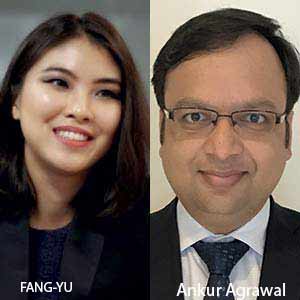THANK YOU FOR SUBSCRIBING

A pragmatic approach to IoT: an insurance perspective
Fang-Yu , Analytics & IoT Domain Lead, AXA & Ankur Agrawal, Head (Director), AXA Rev Singapore [EPA: CS]


Fang-Yu , Analytics & IoT Domain Lead, AXA & Ankur Agrawal, Head (Director), AXA Rev Singapore [EPA: CS]
Most articles on IoT today lie on a dichotomous spectrum of its failure to deliver on customer experience and its promise to be a game changer across multiple industries. Instead of contributing another opinion piece, we would like to share our approach to IoT use cases- an open test-and learn approach that is still pragmatic at its core.
As with any other technological investments, the objective of any IoT deployment should be to solve a business problem. In insurance, it can be explored as a solution for loss-making segments (or accounts) or as a means to activate a new product/ service. If the lossmaking segments stems from the classical principal-agent problem, the insurer can explore existing leverages to correct it, such as rewording the contract to check perverse incentives, or refusing to engage in the business altogether. Only if existing leverages prove insufficient do we turn to more innovative technologies.
The basic premise of IoT deployment in the insurance business is that additional data on the insured asset is useful from an operational and/or risk management perspective. Cargo insurers, for example, rarely have dynamic information on the insured asset- where it is and what physical condition it is in. We have an in-house solution that helps cargo owners track and monitor their cargo. This solution aims to facilitate proactive risk management, streamline claims settlement, and enable us to insure supply chains that were historically “uninsurable” due to our lack of information on the underlying risk.
To elaborate on the last point using an example from health: while most insurers are prudent in underwriting medical policies for elderly or diabetic people, some have started creating innovative offerings and pricing strategies for those who adhere to healthy lifestyle, as tracked by IoT devices.
These products benefit from self-selection (i.e. those who are already living or willing to adopt a healthy lifestyle are more likely than the average person to join these programs) and also create an incentive for healthier lifestyles through a system of rewards/ discounts. A powerful implication of this is that insurers can now provide protection to segments of the population that has been statistically marginalized in the past, thus potentially closing the protection gap. As processors of the customers’ data, however, it is crucial that insurers make it abundantly clear why we are collecting this data and how it will be used. Moreover, it is our duty to ensure the security of our information management systems and compliance to the stated usage of data, or else this single violation of customers’ trust can be the demise of any IoT implementation.
New Generation of Technology – 5G, Edge and Quantum Computing -Will Catalyze the Large-Scale IoT Adoption in Mobility, Health and Industrial Sector
Equally important is the design of the IoT solution itself. In deciding what sensors to incorporate, what computing resources to employ, and what frequency of data to transmit, one inevitably returns to the fundamental question, “what is the marginal cost/benefit of adding such a feature?” Given the decreasing prices of sensors today, it may be tempting to add every sensor conceivable to one’s device, when doing so will only increase the cost of software and hardware maintenance. In the cargo tracking risk management example, prioritize sensors that measures the parameters most correlated with the highest damages (e.g. temperature for cargo fire or humidity for cargo molding). Similarly, there has always been a misguided clamor for “real-time” data in the IoT world, when in reality there are very few business cases in the insurance world that requires this level of immediacy.
Finally, the user design of an IoT solution should not be overlooked. When the solution is expected to support manual work, its design should conform to the pulse and pattern of such work. On the contrary, if it is only expected to monitor status quo, then it needs to be as inconspicuous as possible, lest it interferes with daily operations. In all cases, the precept remains the same: understand the requirements, customize solution (keeping economies of-scale in view), and most importantly, keep in mind design principles to aid in user advocacy and adoption. As with any new technology, gaining user adoption will be an upwards battle, in which the emerging winners will be the corporations that have taken the time to create the right “behavioral nudges” around its IoT products.
We believe that new generation of technology- 5G, Edge and Quantum computing -will catalyze the large-scale IoT adoption in mobility, health and industrial sector. Corporations that approach IoT use cases with a pragmatic mindset will lead the pack in defining innovative customer-centric products and establishing unique partnerships, thereby enabling them to garner first mover advantages through differentiated solutions.
Weekly Brief
I agree We use cookies on this website to enhance your user experience. By clicking any link on this page you are giving your consent for us to set cookies. More info
Read Also













